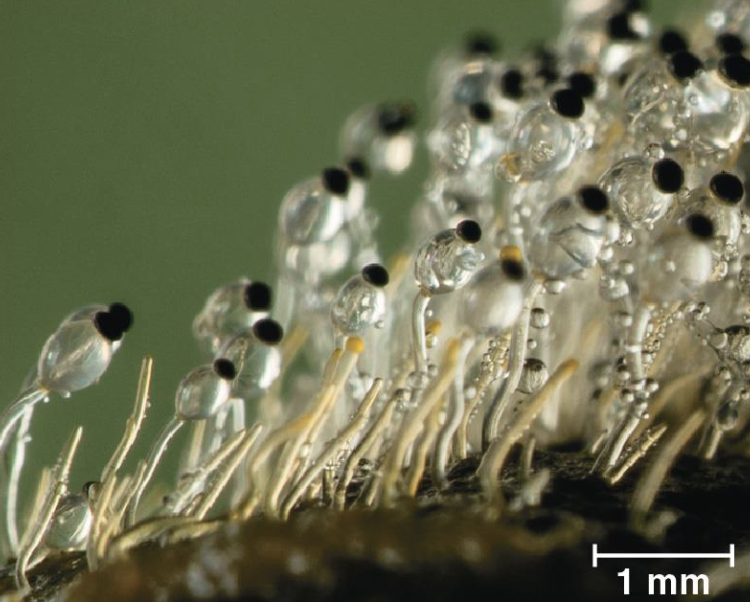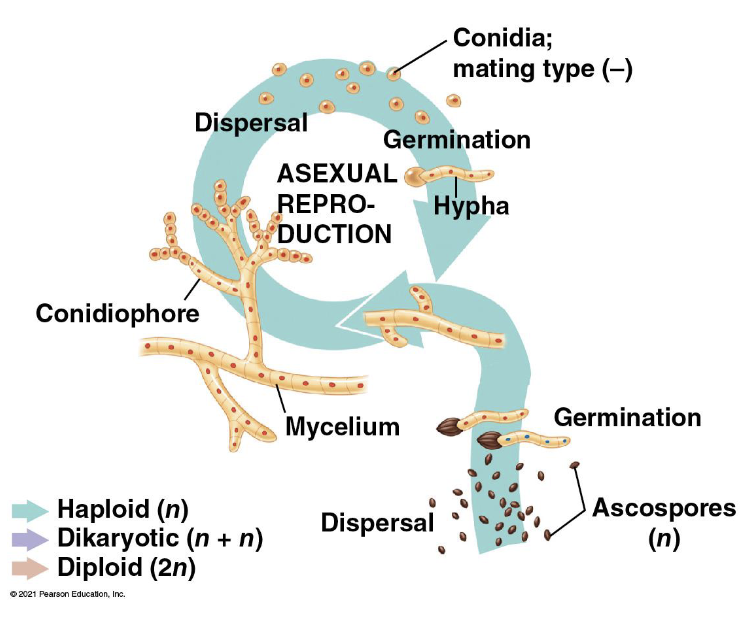Fungi (19) - Egan BISC-120
1/54
There's no tags or description
Looks like no tags are added yet.
Name | Mastery | Learn | Test | Matching | Spaced |
|---|
No study sessions yet.
55 Terms
What two major groups make up unikonts?
amoebozoans which contain only protists
opisthokonts include the fungi and animal kingdoms plus some closely related protists
What are opisthokonts’ features and what groups does it consist of?
They are animals, fungi, and closely related protists. They propel with a singular posterior flagellate cell (think sperm for animals, spores of chytrid fungi)
What are fungi most closely relate to, and what is that group’s function?
nuclearlids; they are amoebas that feed on algae and bacteria
How are fungi characterized?
They are heterotrophic eukaryotes characterized by the absence of phagotrophy and the presence of a chitinous cell wall
What are fungi taxonomically?
monophyletic of nine major lineages
What’s the green hypothesis for fungal transition?
terrestrialization was dependent on terrestrialization in green plants
What’s the brown hypothesis for fungal transition?
zoosporic fungi acquired saprotrophic habits and colonized sediments or damp land — lost flagellum and developed hyphal morphology to complete transition
What’s the white hypothesis for fungal transition?
zoosporic fungi adapted to frozen environments that acted as an intermediate between aquatic and terrestrial environments
What do fungi use to break down complex molecules into smaller organic compounds, and what can they digest?
hydrolytic enzymes; these enzymes can digest compounds from a wide range of sources
Where is the fungal cell wall located?
outside the plasma membrane
What is the fungal cell wall composed of?
glucans, chitin, and glycoproteins
What are some common cell shapes for fungal cells?
spherical, ellipsoidal, cylindrical yeast cells
chains of highly polarized cylindrical cells which form pseudohyphae or hyphae
Some fungi are what?
dimorphic and hold more than one morphology, changing their appearance from environment.
How are hyphae divided in fungi?
hyphae are divided into cells by cross-walls, or septa. Septa have pores large enough to enable cell-to-cell movement of organelles
Hyphae are produced with unique cell types/cellular morphologies during what developmental processes?
asexual and sexual reproduction
pathogenesis for host penetration or host association during symbiosis
proliferation in the environment for absorption
How do fungi propagate themselves?
They produce vast numbers of spores, either asexually or sexually
How do spores spread and germinate?
They are carried long distances by wind or water, and if they land in a most place with water, they will germinate
How do molds produce?
They produce haploid spores asexually by mitosis and form visible, “furry” mycelia
What is mycelium?
a vegetative part of a fungus, consisting of a network of fine, thread-like hyphae
Where do mycelium absorb and transport nutrients?
They absorb nutrients from its environment and transport them to where they are needed for growth and reproductions
Are fungal nuclei and spores diploid or haploid?
haploid
What does sexual reproduction in fungi require?
the fusion of hyphae from different mating types
What are pheromones, and how do fungi use them?
They are sexual signaling molecules and are used to communicate their mating type
What is plasmogamy?
the union of cytoplasm from two parent mycelia
What is a heterokaryon?
a mycelium that contains coexisting, genetically different nuclei
When a haploid nuclei pair off two to a cell, the mycelium is said to be what?
dikaryotic
What is karyogamy?
Karyogamy is the fusion of nuclei after the heterokaryotic stage
What happens after karyogamy?
the haploid nuclei fuse creating a diploid zygote cell
undergoes meiosis, producing haploid spores
How many known species of fungi exist within how many true phyla?
145,000 known species of fungi contained within five true phyla
How were the five phyla established?
according to their mode of sexual reproduction, with two other phyla that reproduce without a sexual cycle in a sixth basal group
What are cryptomycetes?
Cryptomycetes are found globally in soils, marine, and freshwater habitats; they are unicellular and have flagellated spores
What are microsporidians?
unicellular intracellular parasites of protists and animals; their spores infect host cells via a harpoon-like organelle (polar tubule)
What are chytridiomycota?
They are the simplest, most primitive true fungi featuring flagellated spores called zoospores; very similar to protists cell structure-wise
What is chytridiomycosis?
a fatal skin disease caused by chytrid fungal pathogens
What are zoopagomycota?
They form coenocytic hyphae and reproduce asexually via non-flagellated spores.
Zoopagomycetes that reproduce sexually form a structure called a zygosporangium.
What happens during plasmogamy?
Mating type mycelia meet and fuse [their cytoplasm], going into a dikaryotic state
equivalent to sex
sexual incompatibility is determined by molecular recognition mechanisms, controlled by a single mating-type locus
fusion between mycelia of different mating types (plasmogamy) produces zygosporangium
After plasmogamy, what happens next?
They undergo karyogamy, where two nuclei fuse and undergo meiosis to produce spores
What are zygosporangia?
thick-walled structure, they are metabolically inactive and resistant to freezing and drying; when conditions improve, meiosis occurs and they germinate into sporangium
What is sporangium?
they develop at the tips of upright hyphae and function to release sporesÍ›

What are ascomycota?
they form septate hyphae with pores and vary in size and complexity
Why are ascomycetes often called sac fungi?
they have the saclike sci, which spores are produced.
What do ascomycetes produce during the sexual stage?
they produce fruiting bodies called ascocarps which contain the spore-forming asci
How do ascomycetes reproduce?
They reproduce asexually by enormous numbers of asexual spores called conidia produced at the tips of specialized hyphae called conidiophores

What is the cycle of events in ascomycete sexual reproduction?
mycelium from different mating types fuse
dikaryotic cells formed: two haploid nuclei
asci form at the tips of dikaryotic hyphae, and karyogamy and meiosis occur within asci
ascospores develop and discharged from ascocarp
What are basiciomycota?
The phylum is defined by clublike structure called a basidium, a cell in which karyogamy and meiosis occur
What are examples of basidiomycetes?
mushrooms, puffballs, shelf fungi
How do basidiocarps reproduce sexually?
the mycelium produces fruiting bodies called basidiocarps
What is the life cycle of a basidiomycete?
they are long-lived dikaryotic mycelium
basidia experience karyogamy and are diploid nuclei
experience meiosis and basidium contain four haploid nuclei and four basidiospores, then disperse and germinate
What do saprotrophic fungi eat?
They break down and digest decayed (dead/waste) organic matter
What do parasitic fungi absorb?
they absorb nutrients from living hosts (in extreme cases they take over host motor functions)
What do mutualistic fungi absorb?
nutrients from hosts and reciprocate with actions that benefit the host
Why are fungi efficient decomposers?
they can decompose complex plant material such as lignin and cellulose
What are lichens?
symbiotic associations between photosynthetic microorganisms (cyanobacteria or algae) and fungi (mostly ascomycetes)
What are parasites?
a symbiont that consumes host resources (tissues, body fluids)
What is a pathogen?
A type of parasite that causes infectious disease